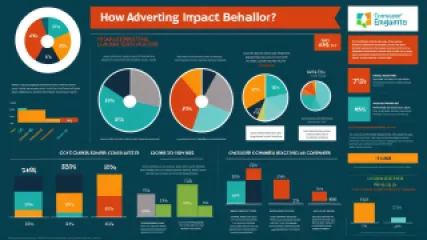How Does Advertising Impact Consumer Behavior?
How Does Advertising Impact Consumer Behavior?
In today's fast-paced and highly competitive world, advertising has become a critical component of any business strategy. From traditional print and television ads to the ever-evolving landscape of digital marketing, the impact of advertising on consumer behavior is a topic of great interest and importance. In this article, we'll delve deep into the various ways in which advertising can influence the decisions and actions of consumers.
The Role of Advertising in Shaping Consumer Perceptions
At its core, advertising is a powerful tool for influencing the way consumers perceive products, services, and brands. Through carefully crafted messages, visuals, and emotional appeals, advertisers can shape the way consumers think about a particular offering, often creating a sense of desire or even necessity.
Brand Awareness and Recognition
One of the primary functions of advertising is to increase brand awareness and recognition. By repeatedly exposing consumers to a brand's name, logo, and messaging, advertisers can ensure that their products or services remain top-of-mind when consumers are considering their options. This heightened brand awareness can play a significant role in the decision-making process, as consumers are more likely to choose a familiar and recognized brand over an unfamiliar one.
Perceived Value and Quality
Advertising can also shape consumers' perceptions of a product's value and quality. Through the use of aspirational imagery, celebrity endorsements, or the portrayal of a product as exclusive or premium, advertisers can convince consumers that a particular offering is worth a higher price tag or is superior to competing products. This perception of value and quality can then influence a consumer's willingness to purchase the advertised product or service.
Emotional Connections
In addition to rational appeals, advertising often relies on emotional connections to capture the attention and loyalty of consumers. By tapping into consumers' desires, fears, or aspirations, advertisers can create a sense of attachment or affinity towards a brand, leading to increased brand loyalty and repeat purchases.
The Impact of Advertising on Consumer Decision-Making
Advertising's influence extends far beyond shaping consumer perceptions – it can also have a direct impact on the decision-making process itself.
Awareness and Consideration
Advertising can play a crucial role in the early stages of the consumer decision-making process, such as raising awareness of a product or service and placing it on the consumer's consideration set. By effectively reaching and engaging potential customers, advertisers can ensure that their offerings are top-of-mind when consumers are ready to make a purchase.
Influencing Preferences and Choices
Through the strategic use of messaging, imagery, and positioning, advertising can also influence consumer preferences and ultimately, their choices. By highlighting unique features, benefits, or social/cultural associations, advertisers can sway consumers towards selecting one product or brand over another.
Reinforcing and Justifying Decisions
Even after a purchase has been made, advertising can continue to play a role in the consumer decision-making process. By reinforcing the consumer's choice and providing ongoing validation, advertising can help solidify their decision and make them less likely to experience buyer's remorse or to consider switching to a competitor's offering.
The Changing Landscape of Advertising and its Impact
As technology and consumer behavior continue to evolve, the landscape of advertising is also undergoing significant transformations. These changes are having a profound impact on the way advertisers reach and engage with consumers.
The Rise of Digital Advertising
The shift towards digital advertising, including platforms such as social media, search engines, and programmatic ad networks, has allowed advertisers to target consumers more precisely, personalize their messaging, and measure the effectiveness of their campaigns with greater accuracy. This, in turn, has changed the way consumers interact with and respond to advertising.
Increased Personalization and Targeting
The vast amount of data available to advertisers through digital platforms has enabled them to create highly personalized and targeted advertising campaigns. By leveraging consumer data and analytics, advertisers can tailor their messages to individual preferences, behaviors, and even locations, making the advertising experience more relevant and engaging for the consumer.
The Rise of Ad Avoidance and Ad Blindness
However, the proliferation of advertising and the increased targeting capabilities have also led to a growing trend of ad avoidance and ad blindness among consumers. As consumers become more savvy and bombarded with advertising messages, they are developing strategies to tune out or avoid these advertisements, posing a new challenge for advertisers.
The Ethical Considerations of Advertising
As the impact of advertising on consumer behavior becomes more apparent, it is essential to consider the ethical implications of advertising practices. Responsible advertisers must grapple with issues such as the truthfulness of their claims, the use of manipulative tactics, and the potential for advertising to contribute to societal issues such as body image, materialism, and the exploitation of vulnerable populations.
Truthfulness and Transparency
One of the fundamental ethical considerations in advertising is the truthfulness and transparency of the messages being conveyed. Advertisers have a responsibility to ensure that their claims are accurate, substantiated, and not misleading. The use of deceptive or exaggerated claims can erode consumer trust and have significant consequences for both the brand and the consumer.
Ethical Targeting and Segmentation
The increased ability to target and personalize advertising raises ethical concerns around the use of consumer data and the potential for exploiting vulnerable populations. Advertisers must carefully consider the ethical implications of their targeting and segmentation strategies, ensuring they do not unfairly target or manipulate consumers.
Societal Impact and Responsibility
Advertising can also have broader societal implications, influencing cultural norms, values, and behaviors. Responsible advertisers must consider the potential impact of their messaging on issues such as body image, gender representation, and the promotion of materialism or unhealthy consumption habits. By prioritizing ethical and socially conscious advertising practices, brands can contribute to a more sustainable and inclusive consumer culture.
Measuring the Effectiveness of Advertising
Evaluating the effectiveness of advertising campaigns is essential for businesses to understand the return on their investment and to optimize their marketing strategies. However, measuring the impact of advertising on consumer behavior can be a complex and multi-faceted endeavor.
Traditional Metrics and KPIs
Traditionally, advertisers have relied on metrics such as impression, reach, click-through rates, and conversions to gauge the effectiveness of their campaigns. While these metrics provide valuable insights, they often fail to capture the deeper impact of advertising on consumer behavior, such as changes in brand perception, purchase intent, and long-term loyalty.
Emerging Techniques and Methodologies
To gain a more comprehensive understanding of advertising's impact, advertisers are increasingly turning to more advanced techniques and methodologies. These include techniques such as consumer surveys, focus groups, eye-tracking studies, and advanced data analysis to uncover the underlying psychological and emotional drivers that influence consumer behavior.
Challenges and Limitations
Measuring the true impact of advertising on consumer behavior is not without its challenges. Factors such as the complex and dynamic nature of consumer decision-making, the difficulty in isolating the impact of advertising from other marketing and environmental factors, and the long-term nature of some advertising effects can make it challenging to accurately attribute changes in consumer behavior to specific advertising campaigns.
Adapting to the Evolving Landscape of Advertising
As the advertising landscape continues to evolve, businesses and advertisers must adapt their strategies and approaches to effectively reach and engage with consumers. This requires a deep understanding of the changing consumer behavior, the impact of new technologies and platforms, and the evolving ethical considerations surrounding advertising practices.
Embracing New Advertising Platforms and Formats
To remain relevant and effective, advertisers must be willing to embrace new advertising platforms and formats as they emerge. This includes exploring the potential of social media, influencer marketing, content marketing, and other innovative approaches that allow for more authentic and engaging interactions with consumers.
Prioritizing Personalization and Relevance
As consumers become increasingly discerning and resistant to intrusive or irrelevant advertising, advertisers must prioritize personalization and relevance in their campaigns. By leveraging data and analytics to create highly targeted and personalized messages, advertisers can enhance the consumer experience and increase the likelihood of successful engagement and conversion.
Fostering Transparency and Building Trust
In an era of heightened consumer awareness and scrutiny, advertisers must prioritize transparency and ethical practices to build and maintain consumer trust. This includes being upfront about their data collection and usage practices, ensuring the truthfulness and accuracy of their claims, and actively addressing concerns about the societal impact of their advertising strategies.
Conclusion
The impact of advertising on consumer behavior is a complex and multifaceted topic that is constantly evolving. From shaping perceptions and influencing decision-making to navigating the ethical considerations and measuring effectiveness, the role of advertising in the consumer landscape is crucial and ever-changing.
As businesses and advertisers navigate this dynamic landscape, it is essential to stay attuned to the shifting trends, technologies, and consumer preferences. By prioritizing personalization, relevance, transparency, and ethical practices, advertisers can effectively reach and engage with consumers, ultimately driving business success and contributing to a more sustainable and responsible consumer culture.
The key takeaways from this article are:
- Advertising plays a significant role in shaping consumer perceptions, influencing brand awareness, perceived value, and emotional connections.
- Advertising can impact various stages of the consumer decision-making process, from awareness and consideration to preference formation and post-purchase reinforcement.
- The rise of digital advertising and personalization has transformed the way consumers interact with and respond to advertising, leading to both opportunities and challenges.
- Ethical considerations in advertising, such as truthfulness, transparency, and societal impact, are crucial for responsible advertisers to address.
- Measuring the effectiveness of advertising on consumer behavior requires a multifaceted approach, incorporating traditional metrics and emerging methodologies.
- Adapting to the evolving landscape of advertising involves embracing new platforms and formats, prioritizing personalization and relevance, and fostering transparency and trust with consumers.
By understanding and addressing these key aspects of advertising's impact on consumer behavior, businesses and advertisers can develop more effective and responsible marketing strategies that resonate with their target audience and contribute to a sustainable consumer culture.






